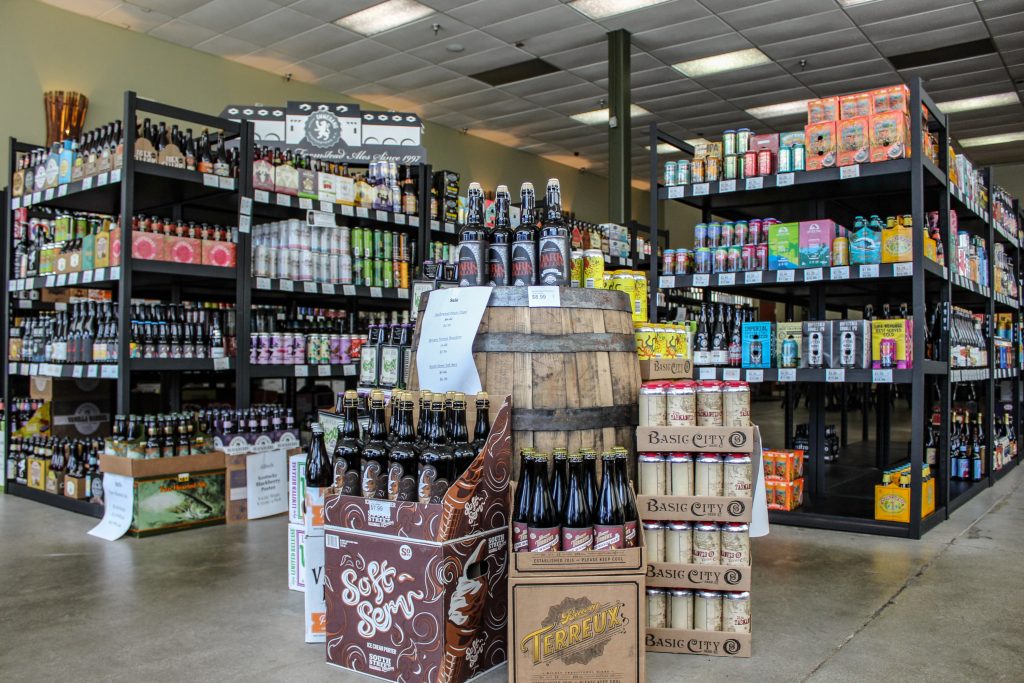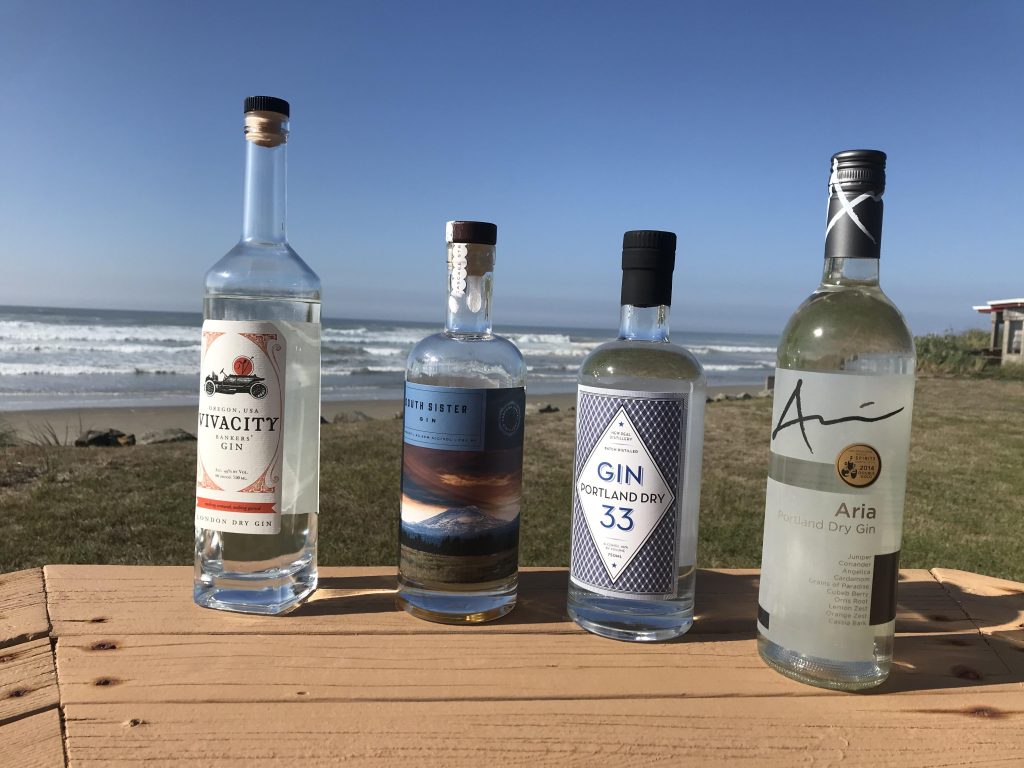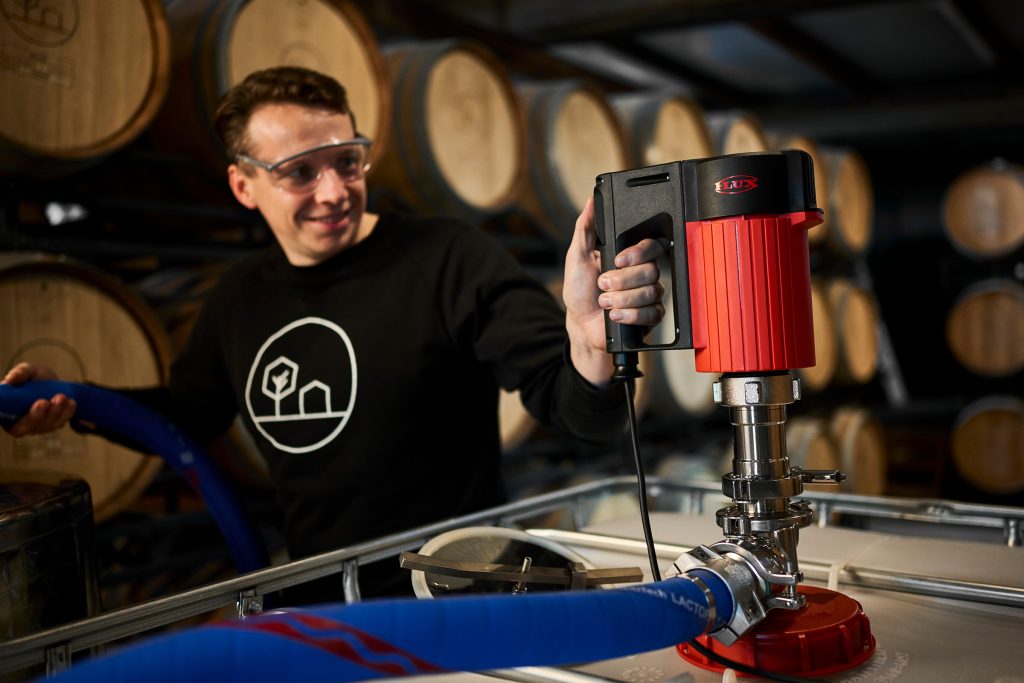
By: Gerald Dlubala
Some distilleries begin with a vision or dream that ultimately comes to fruition after years of systematic, careful research and planning. Some get their start by currently employed, industry-trained distillery professionals that feel they have something unique and personal to offer the distilled spirits world. However, few business plans begin with a strategy that includes jumping in with both feet without prior distilling knowledge. Yet for owners Sara and Brian Winkleman of S & B Farms Distillery in Bancroft, Iowa, this was the chosen path to an award-winning, sought-after line of spirits that continue to impress even the most discerning of bourbon and whiskey drinkers.
The path to distilling started with a simple request from a friend to use Winkleman’s Iowa-grown corn, raised in the rich, nutrient-rich soil widely known to produce exceptional quality crops, to create a quality moonshine. Sara became intrigued as she watched the process of turning their family farm’s corn into moonshine at a Georgia distillery and never looked back. The distilling process piqued her interest, transformed into a fascination and finally resulted in a full-blown infatuation that flared up in her like the burner on a moonshiner’s still. She was hooked, and although her background in cosmetology and her family’s farming experiences hadn’t provided the expertise typically needed to jump into the distilling business, Winkleman would not be denied. She jumped in with both feet for what she described as a turn-and-burn learning experience that would culminate with an award-winning destination distillery that continues to grow and evolve.
“It was not an easy path that I chose, that’s for sure,” said Winkleman. “I really was clueless about the industry, regulations and the whole nine yards. Mentors were critical, and I have to mention Mike Norman, who initially got us into the process, and Dwight Bearden, who helped us with the technical aspects. Our mentors were everything to us. We brought Mike Norman (yes, that Mike Norman) back to Iowa to teach us the most critical and crucial things we needed to know and fully understand. His experience and knowledge were an invaluable part of my passion and infatuation with distilling. At that point, my only way was forward. Having the ability to be taught and learn from a professional using a complete, hands-on approach was a blessing. We had immediate access to all the critical and hidden skills and trade secrets you can’t acquire from books or training videos, like recognizing the right textures and aromas. It can take some distillers years to learn these things without professional help or mentoring.”
S & B Farms Distillery is 17 miles from the Winkleman family farm, where all the corn used in their distillery is still grown. The farm also has cattle, hogs, soybeans, peas and green beans for the nationally recognized Green Giant brand. The field corn is milled on-site weekly, providing the freshest ingredients to use in their spirits, with used mash returned to the farm for the cattle.
“Our distillery, market and tasting room are about 17 miles from the farm,” said Winkleman. “The location was originally a dentist’s office with 13 small, divided rooms constructed of cinder block that we gutted and reconfigured into a distillery production area, tasting room and retail space. Our main and immediate focus at this point was production capability.”
As daunting of a task as it all seemed, trying to accomplish it was admittedly overwhelming at times.
“Networking was everything,” said Winkleman. “And truth be told, I had to walk away for a couple of weeks just to get some mental downtime and refocus. We had the distilling side of the business, but we also had to address the federally regulated side. And Iowa is a controlled state with a different set of rules than other areas. So again, networking played a major role in our success, this time with native distillers, so we could learn how to navigate Iowa’s regulations. We counted on many awesome people and had amazing support, creating a family atmosphere and team system.”
S & B Farms Distillery officially opened in 2018, only a couple of short years after the initial spark of curiosity and twinkle in Sara’s eye. The first products offered to consumers included a spicy pineapple jalapeno moonshine named Field Fire, a bold-spiced savory spirit, and Private First Class, named in honor of Sara’s grandfather, Ray Baade, a World War II veteran and one of her biggest supporters along the distilling journey. There was also their Hog Wild Cinnamon, providing a fresh take on the beloved red-hot candies.
“We never thought about growth potential at the start,” said Winkleman. “Honestly, I just concentrated on trying to hit that sweet spot across the board by producing something that we thought had a pleasing flavor and aroma but also appealed to the tastes and appreciation of consumers. It started great, with immediately positive feedback. We knew we had production where we wanted it to be, and then, of course, the pandemic hit and changed everything. So, like many distilleries, we pivoted to making sanitizers and secured the business of 15 Iowa counties, along with part of Iowa State University.”
Ironically, this COVID-mandated pivot in their business led S & B Farms Distillery to win the 2020 Iowa Farm Bureau’s Renew Rural Iowa (RRI) Award while they grew their network of business contacts across the state.
“Ironically, the whole COVID situation became a bit of a blessing for our business,” said Winkleman. “Our network grew through the sanitizer business. That growth led us to work with knowledgeable people that helped us develop and formulate a solid, workable business plan, find accessible funding, and source local, quality ingredients without the price-gouging that was going on with some suppliers. To this day, we maintain these awesome relationships to consistently review our business plans and change them to include things we never thought of initially, like how to bring our daughter into the business when the time comes.”
The pandemic brought about a nationwide call to support local businesses when possible. That call to action, combined with the surge in consumers buying alcohol for home consumption, meant the demand for S & B Farms products increased while it cut spirits production to meet sanitizer demands.
“With the focus on local support, customers started purchasing more of our products for home use,” said Winkleman. “As that happened, our sales increased. In addition, our Sir Winston Peach Whiskey became wildly popular and was chosen by Casey’s to sell in their stores, further increasing visibility, sales and demand. As a result, we quickly outgrew our small production space and went through a 7,000-square-foot expansion in 2020. We added another still and four fermenters, essentially doubling our production capabilities. We blend, label and bottle on-premises in our controlled environment. I learned the hard way that the steam and humidity put off by the stills can affect proof, which has to be right on. One thing with me is that when I make a mistake, I will never make that again. It’s a learning experience and a teaching lesson.”
If you, like I, were wondering how someone with little to no distilling knowledge or experience goes from deciding to make distilled spirits to an award-winning destination distillery within just a couple of years, Winkleman says it was a true turn-and-burn type process where a lot of things went in their favor once they started. With the help of friends and acquaintances and being the lucky winner of a government draw that helped small businesses get permitted, Winkleman’s business and licensing paperwork was immediately reviewed, deemed correct and accepted for approval. That meant that work could begin immediately instead of having the traditional, more extended wait period that usually occurs.
“We were very blessed and fortunate to be able to open that quickly,” said Winkleman. “I don’t take that for granted. When I left Georgia, I jumped in with both feet to learn and digest all the needed information. There were many 16-hour days of research and learning, not just the process but what type of equipment we needed, how to locate and get that equipment and how to install it. Shop talk with my mentors was crucial and is still as important today as it was back then. It still happens regularly, and I’m truly grateful to have that knowledge base at my disposal.”
Products Reflect Personal Connections
S & B Farms Distillery offers a range of products to please a wide range of palettes. S & B Farm’s Field Fire, Private First Class and Hog Wild accompany the Sir Winston line of spirits, named for their canine family member. Consumers will enjoy the easy-going, laid-back Sir Winston Wheat Whiskey, the classically flavored Sir Winston Bourbon with notes of vanilla, fresh oak and caramel and Sir Winston Peach or Apple for flavored spirit aficionados.
As initially demonstrated by the release of Private First Class, Winkleman has always held great respect for military veterans. That respect and support continue with a non-profit she is starting called “Beyond The Still” to provide support and give back to veterans.
“We bought an old house and property across from our distillery with a vision to transform it into a true veteran’s memorial park, honoring all military veterans within a large memorial area,” said Winkleman. “We estimate that it will take four to five years to complete. Additionally, we continue to offer Coming Home Bourbon, an annual special release that occurs every Veteran’s Day. As you can expect, it is very much in demand and sells out quickly.”
Priority on Flavor Leads to Awards
Winkleman spends a lot of time on her recipes before handing them off to her husband, Brian, for distilling. She tells Beverage Master Magazine that it takes a lot of trial and error, with the ultimate goal of developing a taste that is both satisfying and remarkable in its palette-pleasing qualities. Until she hits on a flavor profile that she deems superior, she doesn’t settle. This way of coming up with her flavor profiles has been very successful, with S & B Farms Distillery winning numerous awards early-on, the latest being a gold medal for their Private First Class at the 2022 Las Vegas Spirits Awards.
Previous Awards and Recognition:
Private First Class – Spiced Spirit
• 2020 USA Spirits Ratings – Silver Medal
• 2019 North American Bourbon and Whiskey Competition – Bronze Medal
• 2019 Denver International Spirits Competition – Silver Medal
Sir Winston Bourbon
• Sir Winston Bourbon Barrel Proof – 2021 North American Bourbon and Whiskey Competition – Silver Medal
• Sir Winston Bourbon 93 Proof – 2021 John Barleycorn Award – Gold Medal
• Sir Winston Barrel Proof – 2020 American Distilling Institute (ADI) Judging of Craft Spirits Awards – Silver Medal
• Sir Winston Bourbon 93 Proof – 2020 Las Vegas Global Wine and Spirits Awards – Gold Medal
• Sir Winston Barrel Proof – 2020 USA Ratings – Gold Medal
• Sir Winston Bourbon 93 Proof – 2019 Great American International Spirits Competition – Bronze Medal
• Sir Winston Barrel Proof – 2019 North American Bourbon and Whiskey Competition – Bronze Medal
Sir Winston Wheat Whiskey
• 2021 John Barleycorn Award – Silver Medal
• 2021 21st Annual Finger Lakes International Wine and Spirits Competition – Silver Medal
• 2021 North American Bourbon and Whiskey Competition – Bronze Medal
• 2021 Denver International Spirits Competition – Gold Medal
• 2020 USA Spirits Ratings – Bronze Medal
Sir Winston Peach
• 2022 Las Vegas Global Spirit Awards – Gold Medal
• 2021 21st Annual Finger Lakes International Wine and Spirits Competition – Silver Medal
• 2020 Denver International Spirits Competition – Silver Medal
• 2020 USA Spirits Ratings – Silver Medal
Hog Wild Cinnamon
• 2020 USA Spirits Ratings – Silver
• 2019 USA Spirits Ratings – Bronze
Field Fire – Spicy Pineapple Jalapeño Moonshine
• 2021 21st Annual Finger Lakes International Wine and Spirits Competition – Silver Medal
Looking Toward Expansion and
Possible Product Additions
“Well, we’ve already maxed out our production capabilities and outgrown our latest 7,000-square-foot production expansion,” said Winkleman. “More expansion will come soon, although we haven’t detailed those plans yet. But it’s coming.”
When asked if she would branch out into perhaps a gin or vodka, Winkleman hesitated a bit and said that currently, there really are no plans to pursue a vodka. But then a spark came through in our conversation that I expected accompanied a twinkle in her eye. “There is, though, perhaps an interest in a rum that’s been running through my mind.”
And by now, I think we all know where that will lead.
For more information please contact…
S & B Farms Distillery
212 E Ramsey St. Bancroft, IA 50517
Email: sbrfarmsdistillery@gmail.com
Website: https://sbfarmsdistillery.com









